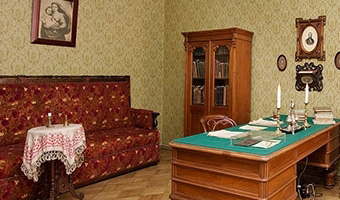In the beginning of October 1878 Fyodor Mikhailovich Dostoevsky and his family moved to apartment at 5 of Kuznechny Lane and lived there till his death on January 28, 1881 . In the Soviet years the building on Kuznechny Lane was reconstructed and later housed ordinary communal apartments.
The memorial plaque was placed on the house of Kuznechny Lane in 1956. In 1968 the house was put to capital repairs, after which the apartment of Dostoevsky was restored by the archive plans and his contemporaries reminiscences.
In November 1971, on Dostoevsky's birthday, the inauguration of the Literature and Memorial Museum of the writer took place.
ENTRY HALL
Anna Grigoryevna wrote: "Our apartment consisted of six rooms, an enormous storeroom for books, an entry hall, and a kitchen, and was on the second floor. Seven windows faced Kuznechny Lane "
Dostoevsky's guests used to pass from the entry hall to the left along the corridor and into the drawing room. Across from the front door is a small washroom which leads into the nursery.
NURSERY
At the time when the family moved to Kuznechny Lane, Liuba was nine years old, and Fedya was seven. In the second marriage the Dostoevskys had four children. The first daughter Sonechka was born in 1868 in Geneva and died in three months. In 1869, in Dresden, Liuba was born, in 1871 in Petersburg Fyodor was born, in 1875 in Staraya Russa where the Dostoyevskys spent their summer Alyosha was born. In spring 1878 the three-year old Alyosha died of an epileptic fit. "Fyodor Mikhailovich was tremendously stricken by this death”. His personal tragic experience reflected in the novel The Brothers Karamazov which Dostoevsky wrote in 1878-1880.
"When we returned to Petersburg in the fall [from the provincial town of Staraya Russa], we decided not to remain in an apartment that was full of reminders of our little boy, and moved to Kuznechny Lane…." wrote in her memoirs Anna Grigoryevna Dostoevskaya.
Dostoevsky believed that life has no sense without children, he was a very caring and loving father. Dostoevsky paid special attention to the education and upbringing of his children. He used to read them aloud the works by Russian and European writers, whom he had known and loved since early youth: Pushkin, Zhukovsky, Karamzin, Gogol, Dickens, Hoffman, Schiller, Hugo, he made them familiar with the Bible using the book he had remembered since his childhood "One Hundred and Four Stories from the Old and the New Testament".
ANNA GRIGORIEVNA'S ROOM
The room of Anna Grigorievna represents a study of a business woman. Her whole life was devoted to her husband. She was a permanent secretary and stenographist to Dostoevsky, she edited his works, was engaged in selling books, settled all financial problems at home, took care of children's upbringing. Dostoevsky highly appreciated his wife's activities: he dedicated to her, his closest friend, his last and main novel.
After Dostoyevsky's death the rest of her life (37 years) Anna Grigorievna collected materials about her husband's life and edited his works. On the basis of those materials " Dostoyevsky's Study" was established in Moscow Emperor's Russian Museum of History in 1901. In 1928 the collection became the basis of the "Dostoyevsky's Museum" which was opened in Moscow .
DINING ROOM
The family used to gather in the dining room only in the evening. Dostoyevsky had got used to work at night since his youth. For his work he needed silence, it was the main condition , however, the house became silent only at night. He started work at 11-12 p. m. and worked till 5-6 o'clock in the morning. Then he had a rest, awoke after noon and then he made himself tea. During the day he was occupied by editing business, but at 6 o’clock all family gathered for the dinner. “Lunch finished at 7 and he enjoyed staying alone till 8 or half past 8 , then he got dressed and went for a walk…”
DRAWING ROOM
In late 70-s Dostoyevsky becomes a famous and popular writer not only in Russia , but also abroad. In 1878 the Emperor's Academy of Sciences chose Dostoyevsky a correspondent member of the Department of the Russian Language and Literature.
Numerous visitors used to come to Dostoyevsky with various problems and requests. Dostoyevsky tried to receive all of them. In late 70-s he was often invited to literary parties with charitable purposes. He spoke in public many a time reading extracts from his works. His contemporaries noted that he possessed a special gift, he changed completely when he read his works.
DOSTOEVSKY's STUDY
The study was reconstructed by the photograph made by V. Taube after the writer's death. There one can see the memorial items: there is a pen, a box from medicine and a wallet on the table, a cache-lettre for papers and letters above the table, an icon of the Virgin in a silver frame in the corner. There are books in book-cases, part of Dostoyevsky's library, which the Museum collects by lists made by Anna Grigoryevna.
Guests seldom got into the study by accident; he used to receive only close friends there. His relatives recollected that he did not like if anything was disturbed in his study ,- manuscripts or books put somewhere else, the chair moved from the place where he had placed it. The study was his creative studio whose special atmosphere no one was to disturb. In this study Dostoyevsky worked at his novel "The Karamazovs Brothers", prepared his famous speech to Pushkin, wrote articles for the last issue of "Writer's Diary" that was published posthumously.

Please reserve guided tours in advance at the Dostoevsky Museum Tour Desk
or contact us at dostoevsky.museum@gmail.com or +7 921 977 43 00
